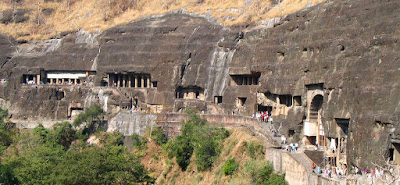Ajanta Ellora Caves have always been recognized as the gems that represent Indian history and the impressive artistry that existed in the foregone era. These tourist attractions consist of 64 rock-cut caves, located in close proximity from the city of Aurangabad. Today, Ajanta and Ellora Caves are a UNESCO World Heritage Site and exist in the wishlist of many travelers. Since we didn’t want your research to be exhausting, we decided to jot down all you need to know before you plan a trip to Ajanta Ellora Caves.
On the other hand, Ellora Caves happen to be younger and have its history dating back to 5th and 10 century CE. The Ellora caves are divided into three parts – Hindu Caves, Jain Caves, and Buddhist Caves. Ajanta is 100 kilometres from the Ellora Caves, which contain Hindu, Jain and Buddhist caves, the last dating from a period similar to Ajanta. The Ajanta style is found in the Ellora caves and other sites such as the Elephanta Caves, Aurangabad Caves, Shivleni Caves and the cave temples of Karnataka. The site of Ajanta Caves was later abandoned and got covered in thick forest, until 1819 when a British officer rediscovered it. However, Ellora Caves have always had the attention it deserves. Today, the Ajanta and Ellora Caves combine to form a UNESCO World Heritage Site, as announced on 1983.
MAJOR ATTRACTIONS
Ajanta and Ellora caves are architectural marvels that are inspiring and have a historic sentiments that cannot be dismissed. These caves a treat to witness. Here are the major attractions or places to visit at the Ajanta And Ellora Caves.
AJANTA CAVES
Ajanta Caves consist of 30 rock-cut caves, showcasing some of the finest paintings and sculptures ever recorded in the Indian history. When exploring this archeological gemstone, don’t miss to visit Cave 1, Cave 2, Cave 4, Cave 16 and Cave 17.
The vantage point across the river allows a lovely view of the surrounding, along with this horse-shaped historical region.
Cave 1: This is one of the most popular caves in Ajanta, as all the paintings are authentic. The grand doorway is adorned with Bodhisattva murals and the sidewalls depict two important phases of Buddha’s life (moment before his enlightenment and when he turned himself into many images)
Cave 2: This cave’s main highlight is its ceiling, which has intricate abstract designs of devils, birds, fruits, and flowers.
Cave 4: This is one of the largest monasteries in Ajanta and still sparks the magic, in spite of being an incomplete creation
ELLORA CAVES
It is apparent that back in the past, there was harmony between Hindus, Buddhists, and Jains, considering close proximity of their religious buildings. Ellora Caves has 34 caves, each of which has its own specialty. If time is a constraint, then you must make it a point to visit at least Cave 1, Cave 2 and Cave 16.
Cave 1: The cave is a simple vihara and features 8 monastic cells
Cave 2: Cave 2 has 12 ornate square pillars. Lord Buddha seated on a lion is yet another attraction. The doorway features an impressive carving of Maitreya Buddha, along with Padmapani holding a lotus.
Cave 16: One of the highlights of Ellora Caves, Cave 16 or Kailash Temple also happens to be an important pilgrimage spot for the followers of Lord Shiva. The gopurams of this architectural marvel signify Mount Kailash, the abode of Lord Shiva.
INTERESTING FACTS
BEST TIME TO VISIT
June to March are the best months to visit Ajanta and Ellora Caves. It becomes a little difficult to travel around and explore the caves in summers April-May. Winters and Monsoon are ideal as the climate is pleasant from October to March and June to September which is the best time to visit the caves. Avoid summers if you don't want the sun to bother you while you are enjoying your archaeological journey. The scorching heat of April and May makes it a bit challenging for the tourists.
TIMINGS AND FEE
AJANTA CAVES
Timings: 9 am to 9:30 pm (Mondays closed)
Entry fee: INR 40 per head (Indians) | INR 600 per head (foreign tourists) | INR 25 per camera | INR 0 for children below 15 years old
ELLORA CAVES
Timings: From sunrise to sunset
Entry fee: INR 40 per head (Indians) | INR 600 per head (foreign tourists) | INR 25 per camera
WANT TO EXPLORE AJANTA CAVES? THEN DO CHECK THIS VIDEO OUT.......👉 AJANTA ELLORA CAVES
STAY TUNED FOR EXPLORING MANY MORE AMAZING LOCATIONS!!!!
-NANDINI SAJEEV

















Great👏
ReplyDeleteAmazing 👌
ReplyDeleteHeavy👌
ReplyDeleteSimply amazing work ✌
ReplyDelete